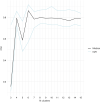Clustering identifies endotypes of traumatic brain injury in an intensive care cohort: a CENTER-TBI study
- PMID: 35897070
- PMCID: PMC9327174
- DOI: 10.1186/s13054-022-04079-w
Clustering identifies endotypes of traumatic brain injury in an intensive care cohort: a CENTER-TBI study
Abstract
Background: While the Glasgow coma scale (GCS) is one of the strongest outcome predictors, the current classification of traumatic brain injury (TBI) as 'mild', 'moderate' or 'severe' based on this fails to capture enormous heterogeneity in pathophysiology and treatment response. We hypothesized that data-driven characterization of TBI could identify distinct endotypes and give mechanistic insights.
Methods: We developed an unsupervised statistical clustering model based on a mixture of probabilistic graphs for presentation (< 24 h) demographic, clinical, physiological, laboratory and imaging data to identify subgroups of TBI patients admitted to the intensive care unit in the CENTER-TBI dataset (N = 1,728). A cluster similarity index was used for robust determination of optimal cluster number. Mutual information was used to quantify feature importance and for cluster interpretation.
Results: Six stable endotypes were identified with distinct GCS and composite systemic metabolic stress profiles, distinguished by GCS, blood lactate, oxygen saturation, serum creatinine, glucose, base excess, pH, arterial partial pressure of carbon dioxide, and body temperature. Notably, a cluster with 'moderate' TBI (by traditional classification) and deranged metabolic profile, had a worse outcome than a cluster with 'severe' GCS and a normal metabolic profile. Addition of cluster labels significantly improved the prognostic precision of the IMPACT (International Mission for Prognosis and Analysis of Clinical trials in TBI) extended model, for prediction of both unfavourable outcome and mortality (both p < 0.001).
Conclusions: Six stable and clinically distinct TBI endotypes were identified by probabilistic unsupervised clustering. In addition to presenting neurology, a profile of biochemical derangement was found to be an important distinguishing feature that was both biologically plausible and associated with outcome. Our work motivates refining current TBI classifications with factors describing metabolic stress. Such data-driven clusters suggest TBI endotypes that merit investigation to identify bespoke treatment strategies to improve care. Trial registration The core study was registered with ClinicalTrials.gov, number NCT02210221 , registered on August 06, 2014, with Resource Identification Portal (RRID: SCR_015582).
Keywords: Critical care; Endotypes; Intensive care unit; Machine learning; Traumatic brain injury; Unsupervised clustering.
© 2022. The Author(s).
Conflict of interest statement
DM reports grants, personal fees and non-financial support from GlaxoSmithKline, grants and personal fees from NeuroTrauma Sciences, personal fees from Pfizer Ltd, personal fees from PressuraNeuro, grants and personal fees from Lantmannen AB, grants and personal fees from Integra, outside the submitted work. All other authors declare no competing interests.
Figures






References
-
- Steyerberg EW, Wiegers E, Sewalt C, Buki A, Citerio G, De Keyser V, et al. Case-mix, care pathways, and outcomes in patients with traumatic brain injury in CENTER-TBI: a European prospective, multicentre, longitudinal, cohort study. Lancet Neurol. 2019;18(10):923–934. doi: 10.1016/S1474-4422(19)30232-7. - DOI - PubMed

